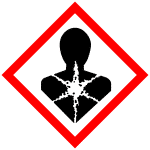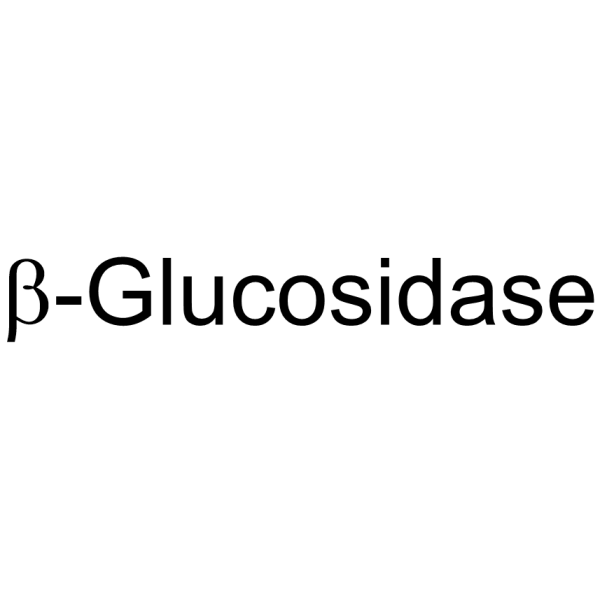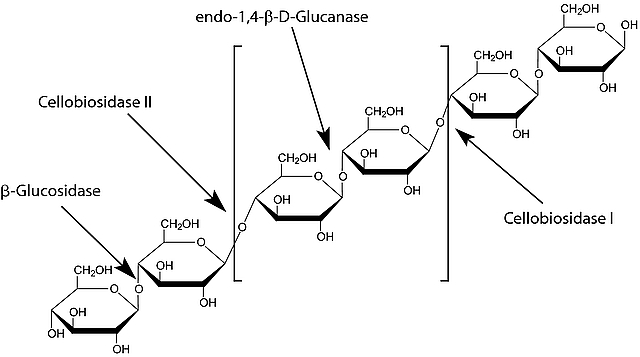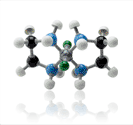β-葡萄糖苷酶,β-Glucosidase, from almonds, ≥100 u/g
产品编号:Bellancom-W208039| CAS NO:9001-22-3| MDL NO:MFCD00130628| 分子式:Null,without related properties.| 分子量:Null,without related properties.
β-葡萄糖苷酶是纤维素降解的限速酶。β-葡萄糖苷酶是糖苷水解酶中的一个主要基团。β-葡萄糖苷酶参与土壤中纤维素的降解,具有监测生物土壤质量的潜力。
本网站销售的所有产品仅用于工业应用或者科学研究等非医疗目的,不可用于人类或动物的临床诊断或者治疗,非药用,非食用,
| 产品名称 | β-葡萄糖苷酶 |
|---|---|
| 英文名称 | β-Glucosidase, from almonds, ≥100 u/g |
| CAS编号 | 9001-22-3 |
| 产品描述 | β-葡萄糖苷酶是纤维素降解的限速酶。β-葡萄糖苷酶是糖苷水解酶中的一个主要基团。β-葡萄糖苷酶参与土壤中纤维素的降解,具有监测生物土壤质量的潜力。 |
| 精确质量 | 283.06900 |
| PSA | 124.97000 |
| LogP | 0.01710 |
| 外观性状 | powder | gray-brown |
| 稳定性 | 是一种具有生物催化剂功能的蛋白质,为苦杏仁酶的主要有效成分。 对温度、PH和导致蛋白质变性的各种因素均非常敏感,极易受到外界条件的影响而改变其本身的构象和性质 |
| 储存条件 | 2-8°C密闭、阴凉干燥处 |
相关文档
化学品安全说明书(MSDS)
下载MSDS质检证书(COA)
相关产品
| 符号 |

GHS08 |
|---|---|
| 信号词 | Danger |
| 危害声明 | H334 |
| 警示性声明 | P261-P342 + P311 |
| 个人防护装备 | dust mask type N95 (US);Eyeshields;Faceshields;Gloves |
| 危害码 (欧洲) | Xn |
| 风险声明 (欧洲) | 42 |
| 安全声明 (欧洲) | 23-45-36/37-24-22 |
| 危险品运输编码 | NONH for all modes of transport |
| WGK德国 | 3 |
| 海关编码 | 35079090 |
|
Section I.Chemical Product and Company Identification Chemical Name Beta-Glucosidase, from Almonds Portland OR Synonym Amygdalase Chemical Formula Not available.
CAS Number 9001-22-3 (International) Section II.Composition and Information on Ingredients Chemical NameCAS Number Percent (%)TLV/PELToxicology Data Beta-Glucosidase, from AlmondsNot available.Not available.Not available. 9001-22-3 Section III.Hazards Identification Acute Health Effects Harmful if ingested or inhaled. Minimize exposure to this material. Severe overexposure can result in injury or death. Follow safe industrial hygiene practices and always wear proper protective equipment when handling this compound. Chronic Health EffectsCARCINOGENIC EFFECTS : Not available. MUTAGENIC EFFECTS : Not available. TERATOGENIC EFFECTS : Not available. DEVELOPMENTAL TOXICITY : Not available. Repeated or prolonged exposure to this compound is not known to aggravate existing medical conditions. Section IV.First Aid Measures Eye Contact C heck for and rem ove any contact lenses. In case of contact, im m ediately flush eyes w ith plenty of w ater for at least 15 minutes. Get medical attention. Skin Contact In case of contact, im m ediately flush skin w ith plenty of w ater. Rem ove contam inated clothing and shoes. W ash clothing before reuse. Thoroughly clean shoes before reuse. Get medical attention. Inhalation If the victim is not breathing, perform m outh-to-m outh resuscitation. Loosen tight clothing such as a collar, tie, belt or w aistband. If breathing is difficult, oxygen can be adm inistered. Seek m edical attention if respiration problem s do not improve. Ingestion IN D U C E V O M ITIN G by sticking finger in throat. Low er the head so that the vom it w ill not reenter the m outh and throat. Loosen tight clothing such as a collar, tie, belt or w aistband. If the victim is not breathing, perform m outh-to-m outh resuscitation. Exam ine the lips and m outh to ascertain w hether the tissues are dam aged, a possible in dication that the toxic material was ingested; the absence of such signs, however, is not conclusive. Section V.Fire and Explosion Data Auto-Ignition FlammabilityNot available. May be combustible at high temperature. Flash PointsFlammable Limits Not available. Not available. Combustion Products These products include toxic carbon oxides (CO,CO2), nitrogen oxides (NOx ), sulfur oxides (SOx ). Fire Hazards Not available. Explosion Hazards Risks of explosion of the product in presence of mechanical impact: Not available. Risks of explosion of the product in presence of static discharge: Not available. Fire Fighting Media SMALL FIRE: Use DRY chemical powder. and InstructionsLARGE FIRE: Use water spray, fog or foam. DO NOT use water jet. Consult with local fire authorities before attempting large scale fire-fighting operations. Continued on Next Page Beta-Glucosidase, from Almonds Section VI.Accidental Release Measures Spill Cleanup Harmful Material. InstructionsU se a shovel to put the m aterial into a convenient w aste disposal container. Finish cleaning the spill by rinsing any contam inated surfaces w ith copious am ounts of w ater. C onsult federal, state, and/or local authorities for assistance on disposal. Section VII.Handling and Storage Handling and Storage H A RM FU L. REFRIG ERA TE. K eep aw ay from heat. M echanical exhaust required.W hen not in use, tightly seal the container and store in a dry, cool place. Avoid excessive heat and light. Do not breathe dust. Information Always store away from incompatible compounds such as oxidizing agents. Section VIII.Exposure Controls/Personal Protection Engineering Controls U se process enclosures, local exhaust ventilation, or other engineering controls to keep airborne levels below recom m ended exposure lim its. If user operations generate dust, fum e or m ist, use ventilation to keep exposure to airborne contaminants below the exposure limit. Personal Protection Splash goggles. Lab coat. D ust respirator. Boots. G loves. Suggested protective clothing m ight not be sufficient; consult a specialist BEFORE handling this product. Be sure to use a MSHA/NIOSH approved respirator or equivalent. Exposure Limits Not available. Section IX.Physical and Chemical Properties Physical state @ 20°CSolubility Solid. (Light Yellow Powder.) Not available. Specific GravityNot available. Molecular WeightPartition Coefficient Not available. Not available. Boiling PointVapor Pressure Not available.Not applicable. Melting PointVapor Density Not available.Not available. Refractive IndexVolatility Not available.Not available. Critical TemperatureOdor Not available.Not available. ViscosityTaste Not available.Not available. Section X.Stability and Reactivity Data Stability This material is stable if stored under proper conditions. (See Section VII for instructions) Conditions of Instability Avoid excessive heat and light. Incompatibilities Reactive with oxidizing agents. Section XI.Toxicological Information RTECS Number Not available. Routes of Exposure Eye Contact. Ingestion. Inhalation. Toxicity Data Not available. Chronic Toxic EffectsCARCINOGENIC EFFECTS : Not available. MUTAGENIC EFFECTS : Not available. TERATOGENIC EFFECTS : Not available. DEVELOPMENTAL TOXICITY : Not available. Repeated or prolonged exposure to this compound is not known to aggravate existing medical conditions. Acute Toxic Effects Harmful if ingested or inhaled. Minimize exposure to this material. Severe overexposure can result in injury or death. Follow safe industrial hygiene practices and always wear proper protective equipment when handling this compound. Section XII.Ecological Information Ecotoxicity Not available. Environmental Fate Not available. Continued on Next Page Beta-Glucosidase, from Almonds Section XIII.Disposal Considerations Waste DisposalRecycle to process, if possible. C onsult your local regional authorities. You m ay be able to dissolve or m ix m aterial w ith a com bustible solvent and burn in a chem ical incinerator equipped w ith an afterburner and scrubber system . O bserve all federal, state and local regulations when disposing of the substance. Section XIV.Transport Information DOT Classification Not a DOT controlled material (United States). PIN Number Not applicable. Proper Shipping Name Not applicable. Packing Group (PG) Not applicable. DOT Pictograms Section XV.Other Regulatory Information and Pictograms TSCA Chemical Inventory ON the EPA Toxic Substances Control Act (TSCA) inventory list. This compound is (EPA) WHMIS Classification On NDSL. (Canada) EINECS Number (EEC) 232-589-7 EEC Risk Statements R20/21/22- Harmful by inhalation, in contact with skin and if swallowed. Japanese Regulatory Data Not available. Section XVI. Version 1.0 Validated on 2/15/2007. SECTION 16 - ADDITIONAL INFORMATION N/A |










 浙公网安备 33010802013016号
浙公网安备 33010802013016号